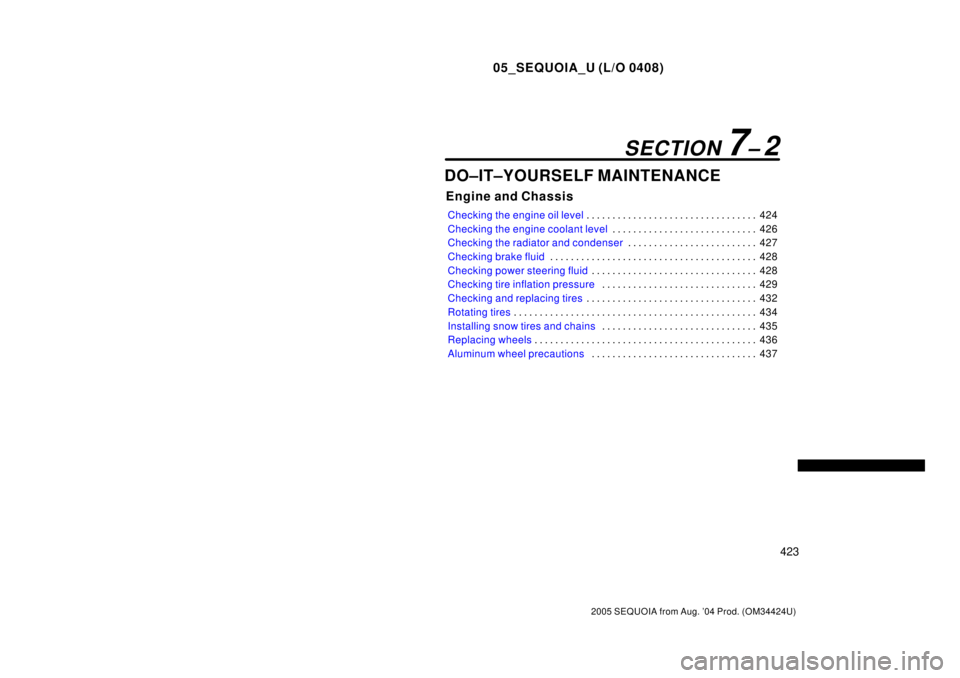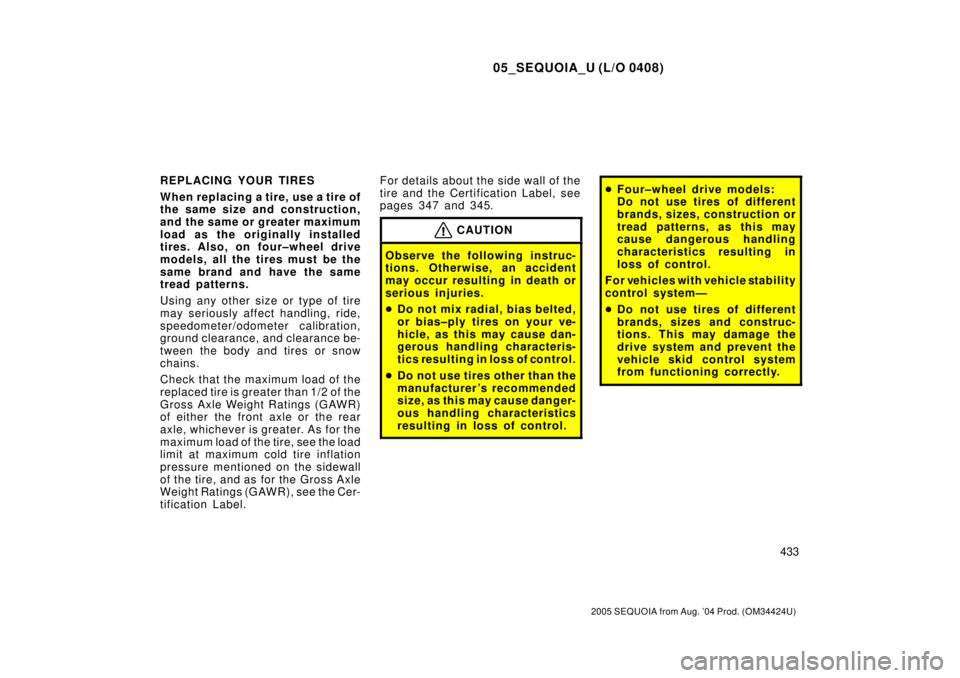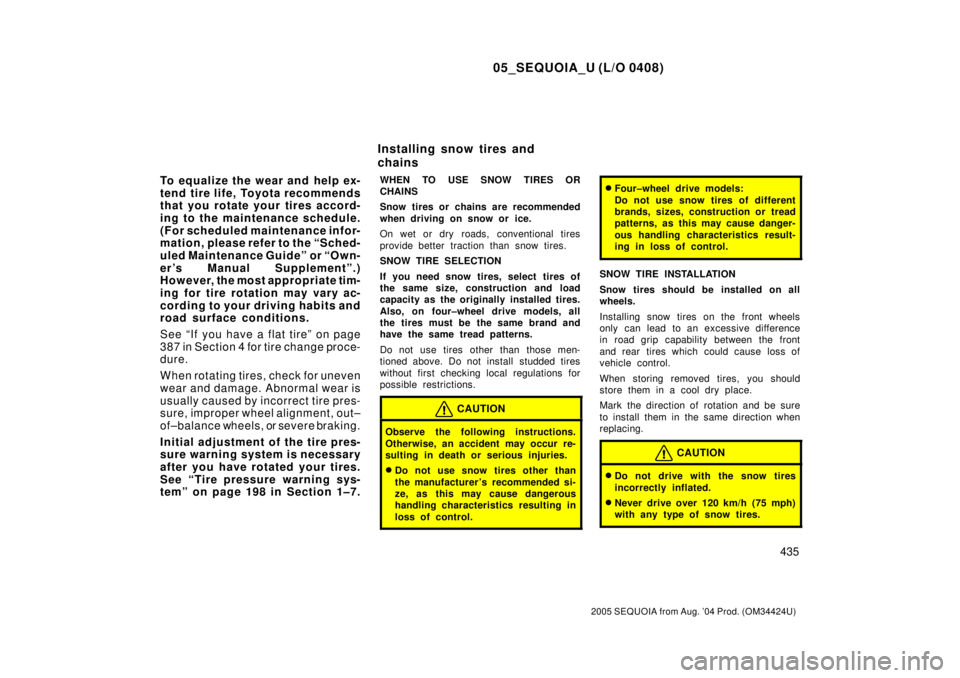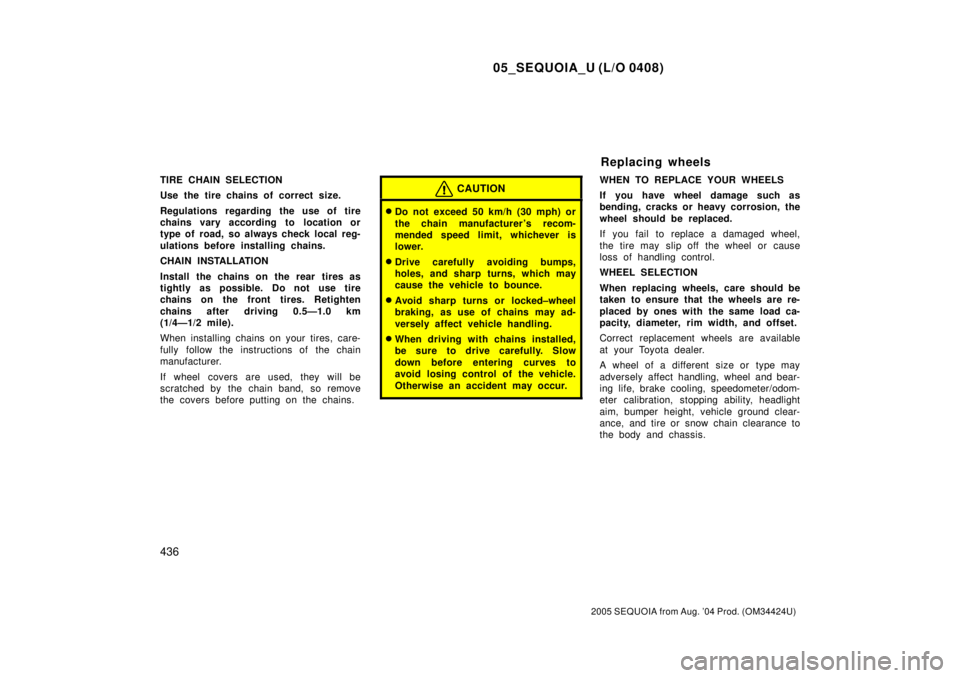Page 4282 of 4323

05_SEQUOIA_U (L/O 0408)
423
2005 SEQUOIA from Aug. '04 Prod. (OM34424U)
DO±IT±YOURSELF MAINTENANCE
Engine and Chassis
Checking the engine oil level424 . . . . . . . . . . . . . . . . . . . . . . . . . . . . . . . . .
Checking the engine coolant level426 . . . . . . . . . . . . . . . . . . . . . . . . . . . .
Checking the radiator and condenser427 . . . . . . . . . . . . . . . . . . . . . . . . .
Checking brake fluid428 . . . . . . . . . . . . . . . . . . . . . . . . . . . . . . . . . . . . . . . .
Checking power steering fluid428 . . . . . . . . . . . . . . . . . . . . . . . . . . . . . . . .
Checking tire inflation pressure429 . . . . . . . . . . . . . . . . . . . . . . . . . . . . . .
Checking and replacing tires432 . . . . . . . . . . . . . . . . . . . . . . . . . . . . . . . . .
Rotating tires434 . . . . . . . . . . . . . . . . . . . . . . . . . . . . . . . . . . . . . . . . . . . . . . .
Installing snow tires and chains435 . . . . . . . . . . . . . . . . . . . . . . . . . . . . . .
Replacing wheels436 . . . . . . . . . . . . . . . . . . . . . . . . . . . . . . . . . . . . . . . . . . .
Aluminum wheel precautions437 . . . . . . . . . . . . . . . . . . . . . . . . . . . . . . . .
SECTION 7± 2
Page 4292 of 4323

05_SEQUOIA_U (L/O 0408)
433
2005 SEQUOIA from Aug. '04 Prod. (OM34424U)
REPLACING YOUR TIRES
When replacing a tire, use a tire of
the same size and construction,
and the same or greater maximum
load as the originally installed
tires. Also, on four±wheel drive
models, all the tires must be the
same brand and have the same
tread patterns.
Using any other size or type of tire
may seriously affect handling, ride,
speedometer/odometer calibration,
ground clearance, and clearance be-
tween the body and tires or snow
chains.
Check that the maximum load of the
replaced tire is greater than 1/2 of the
Gross Axle Weight Ratings (GAWR)
of either the front axle or the rear
axle, whichever is greater. As for the
maximum load of the tire, see the load
limit at maximum cold tire inflation
pressure mentioned on the sidewall
of the tire, and as for the Gross Axle
Weight Ratings (GAWR), see the Cer-
tification Label.For details about the side wall of the
tire and the Certification Label, see
pages 347 and 345.
CAUTION
Observe the following instruc-
tions. Otherwise, an accident
may occur resulting in death or
serious injuries.
�Do not mix radial, bias belted,
or bias±ply tires on your ve-
hicle, as this may cause dan-
gerous handling characteris-
tics resulting in loss of control.
�Do not use tires other than the
manufacturer's recommended
size, as this may cause danger-
ous handling characteristics
resulting in loss of control.
�Four±wheel drive models:
Do not use tires of different
brands, sizes, construction or
tread patterns, as this may
cause dangerous handling
characteristics resulting in
loss of control.
For vehicles with vehicle stability
control systemÐ
�Do not use tires of different
brands, sizes and construc-
tions. This may damage the
drive system and prevent the
vehicle skid control system
from functioning correctly.
Page 4294 of 4323

05_SEQUOIA_U (L/O 0408)
435
2005 SEQUOIA from Aug. '04 Prod. (OM34424U)
To equalize the wear and help ex-
tend tire life, Toyota recommends
that you rotate your tires accord-
ing to the maintenance schedule.
(For scheduled maintenance infor-
mation, please refer to the ªSched-
uled Maintenance Guideº or ªOwn-
er's Manual Supplementº.)
However, the most appropriate tim-
ing for tire rotation may vary ac-
cording to your driving habits and
road surface conditions.
See ªIf you have a flat tireº on page
387 in Section 4 for tire change proce-
dure.
When rotating tires, check for uneven
wear and damage. Abnormal wear is
usually caused by incorrect tire pres-
sure, improper wheel alignment, out±
of±balance wheels, or severe braking.
Initial adjustment of the tire pres-
sure warning system is necessary
after you have rotated your tires.
See ªTire pressure warning sys-
temº on page 198 in Section 1±7.WHEN TO USE SNOW TIRES OR
CHAINS
Snow tires or chains are recommended
when driving on snow or ice.
On wet or dry roads, conventional tires
provide better traction than snow tires.
SNOW TIRE SELECTION
If you need snow tires, select tires of
the same size, construction and load
capacity as the originally installed tires.
Also, on four±wheel drive models, all
the tires must be the same brand and
have the same tread patterns.
Do not use tires other than those men-
tioned above. Do not install studded tires
without first checking local regulations for
possible restrictions.
CAUTION
Observe the following instructions.
Otherwise, an accident may occur re-
sulting in death or serious injuries.
�Do not use snow tires other than
the manufacturer 's recommended si-
ze, as this may cause dangerous
handling characteristics resulting in
loss of control.
�Four±wheel drive models:
Do not use snow tires of different
brands, sizes, construction or tread
patterns, as this may cause danger-
ous handling characteristics result-
ing in loss of control.
SNOW TIRE INSTALLATION
Snow tires should be installed on all
wheels.
Installing snow tires on the front wheels
only can lead to an excessive difference
in road grip capability between the front
and rear tires which could cause loss of
vehicle control.
When storing removed tires, you should
store them in a cool dry place.
Mark the direction of rotation and be sure
to install them in the same direction when
replacing.
CAUTION
�Do not drive with the snow tires
incorrectly inflated.
�Never drive over 120 km/h (75 mph)
with any type of snow tires.
Installing snow tires and
chains
Page 4295 of 4323

05_SEQUOIA_U (L/O 0408)
436
2005 SEQUOIA from Aug. '04 Prod. (OM34424U)
TIRE CHAIN SELECTION
Use the tire chains of correct size.
Regulations regarding the use of tire
chains vary according to location or
type of road, so always check local reg-
ulations before installing chains.
CHAIN INSTALLATION
Install the chains on the rear tires as
tightly as possible. Do not use tire
chains on the front tires. Retighten
chains after driving 0.5Ð1.0 km
(1/4Ð1/2 mile).
When installing chains on your tires, care-
fully follow the instructions of the chain
manufacturer.
If wheel covers are used, they will be
scratched by the chain band, so remove
the covers before putting on the chains.CAUTION
�Do not exceed 50 km/h (30 mph) or
the chain manufacturer 's recom-
mended speed limit, whichever is
lower.
�Drive carefully avoiding bumps,
holes, and sharp turns, which may
cause the vehicle to bounce.
�Avoid sharp turns or locked±wheel
braking, as use of chains may ad-
versely affect vehicle handling.
�When driving with chains installed,
be sure to drive carefully. Slow
down before entering curves to
avoid losing control of the vehicle.
Otherwise an accident may occur.
WHEN TO REPLACE YOUR WHEELS
If you have wheel damage such as
bending, cracks or heavy corrosion, the
wheel should be replaced.
If you fail to replace a damaged wheel,
the tire may slip off the wheel or cause
loss of handling control.
WHEEL SELECTION
When replacing wheels, care should be
taken to ensure that the wheels are re-
placed by ones with the same load ca-
pacity, diameter, rim width, and offset.
Correct replacement wheels are available
at your Toyota dealer.
A wheel of a different size or type may
adversely affect handling, wheel and bear-
ing life, brake cooling, speedometer/odom-
eter calibration, stopping ability, headlight
aim, bumper height, vehicle ground clear-
ance, and tire or snow chain clearance to
the body and chassis.
Replacing wheels